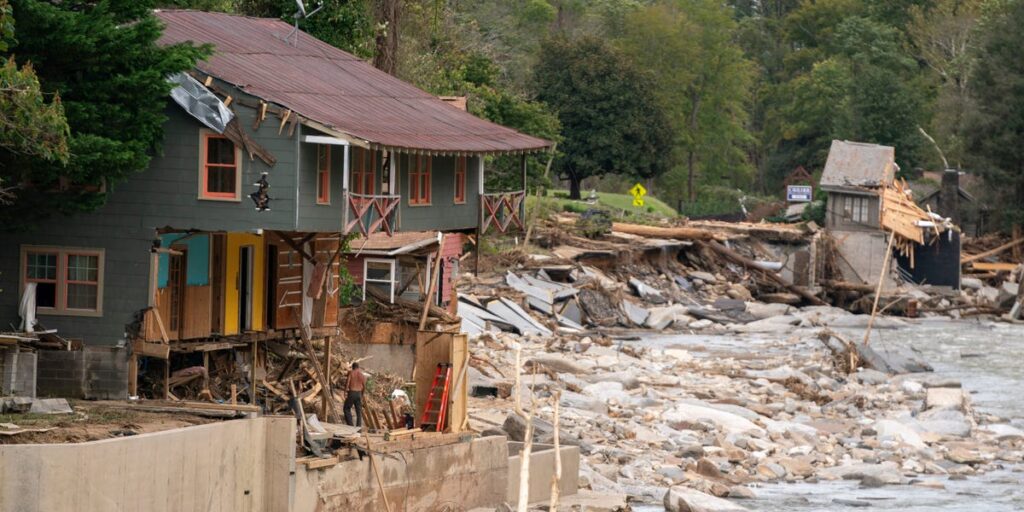- Rains from Hurricane Helene caused severe flooding in western North Carolina, devastating communities.
- But less than 3% of properties in the state have flood insurance, leaving many unprotected.
- Part of the problem is that people falsely assume they’re not at risk, experts said.
Torrential rains from Hurricane Helene wreaked havoc on western North Carolina last week, with flooding that has devastated local communities, killed dozens in the state, left many residents without running water or power, uprooted businesses, and destroyed homes.
Rainfall collected by at least a dozen weather stations in the region, including near Asheville, reached their highest-ever 3-day totals during the event, ranging from nearly 13 inches to over 31 inches, according to a report from the North Carolina State Climate Office.
But only about 2.6% of the 4.3 million properties across the state — or around 115,000 properties — had flood insurance as of June 2024, according to private provider Neptune Flood Insurance, which analyzed data from the government-backed National Flood Insurance Program. And that’s a 2.5% year-over-year coverage decrease from June 2023, Neptune said.
North Carolina Department of Insurance communications director Jason Tyson estimated that about 139,000 properties in the state have flood insurance through the NFIP.
Neither estimate includes private flood insurance. But the number of private flood insurance policies in the US is small compared to the amount of NFIP policies, according to a 2023 report from independent insurance provider PolicyGenius.
The North Carolina Joint Information Center told Business Insider that it’s still too early to provide estimates on the number of buildings damaged or the total cost of the damages.
Federal disaster assistance does help people who lost their homes with mortgage payments, home loans, or bill payments. But without flood insurance, many homeowners may be left with a significant financial burden.
Part of the problem with flood insurance is a common misconception that regular home insurance covers flooding, which is rarely the case, four experts knowledgable about flood insurance and disaster management told Business Insider.
“They just think that, ‘Oh, yeah, I have insurance. I have homeowner’s insurance. I have State Farm or whatever. That must cover it,'” Trevor Burgess, the President & CEO of Neptune Flood Insurance, told BI. “And it doesn’t. They have to buy a separate policy.”
Another factor influencing why so few people have flood insurance is that it’s not required for everyone — only homes and businesses with government-backed mortgages in areas that are designated high-risk flood zones are legally required to have flood insurance.
“One of the biggest drivers of whether or not people get flood insurance is whether or not they’re required to have it,” Jeffrey Schlegelmilch, a research scholar and director of the National Center for Disaster Preparedness (NCDP) at Columbia Climate School, told BI.
“So if you don’t live in one of these areas, one of these floodplains that trigger that, then a lot of people just simply don’t get flood insurance,” Schlegelmilch added.
Margaret Walls, a senior fellow and director of the Climate Risks and Resilience Program at nonprofit research institute Resources for the Future, said that people also wrongly believe that if they’re not in a high-risk flood area, then they’re not at risk.
“It’s not a lot of homes that are in those designated floodplains relative to the total number of homes, but there’s still a lot of flood risks,” Walls said. “And this is one of the biggest issues in the flood world is that the mapped areas where FEMA says you’re supposed to have flood insurance policy are not the areas that are all risky. There are plenty of areas where you’re at risk outside of those mapped areas.”
Walls explained that people don’t understand their actual risks.
“They think that the map is telling them their risks,” Walls said. “It’s actually not. It’s just telling them where they have to have a mandatory purchase of a flood insurance policy. But it’s not saying that you’re zero risk when you’re outside of that area. And as climate changes happening, those risks are going up.”
And the areas devastated by flooding in western North Carolina were largely not considered to be high-risk flood areas. The State of North Carolina’s Flood Risk Information System designates many of the counties in the region that were most affected by flooding after Helene as “minimal flood risk,” according to a map on their website.
“We almost always associate flood risk with hurricanes and coastal storm surge in Florida, Louisiana, and Texas,” Jeremy Porter, who leads climate implication research at First Street, a public-benefit corporation that evaluates climate risk, told The Associated Press. “We don’t think of western North Carolina and the Appalachian mountains as an area that has significant flood risk.”
And the perception that a certain place is safe from flooding contributes to the problem, Schlegelmilch suggested.
“This is one of those things we look at areas like Asheville, North Carolina, that were thought of as climate havens, where people thought, ‘Well, I’m going to escape the worst of climate change and I’m going to move there,'” Schlegelmilch said. “And unfortunately, this is just an important reminder that we cannot outrun this.”
Having insurance to protect your home and mitigate your financial risks is an important step, and more people need to take that precaution, Schlegelmilch said, a sentiment that Walls and Burgess also echoed.
Yanjun Liao, an economist and fellow at Resources for the Future, added that people should be prepared for even unexpected flood events, like what happened in western North Carolina.
“I definitely think that a lot more people need flood insurance,” Liao said. “Oftentimes even people who are living outside of the flood zones, the 100-year flood zones and sometimes outside 500-year flood zones, can face these kind of unexpected flood damage.”
Liao said that the cost of flood insurance can be burdensome, particularly for those who live in more disaster-prone areas. But the alternative may be even more costly: rebuilding after a devastating storm.
Read the full article here
















